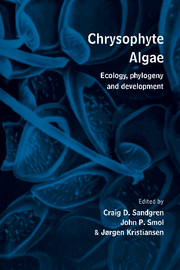Book contents
- Frontmatter
- Contents
- Preface
- List of contributors
- 1 History of chrysophyte research: origin and development of concepts and ideas
- Part I Phylogeny, systematics and evolution
- Part II Development, physiology and nutrition
- Part III Ecology, paleoecology and reproduction
- 9 Chrysophyte blooms in the plankton and neuston of marine and freshwater systems
- 10 Biogeography of chrysophytes in Finnish lakes
- 11 The distribution of chrysophytes along environmental gradients: their use as biological indicators
- 12 The influence of zooplankton herbivory on the biogeography of chrysophyte algae
- 13 Application of chrysophytes to problems in paleoecology
- Part IV Contributed original papers
- Index of scientific names
- Subject index
11 - The distribution of chrysophytes along environmental gradients: their use as biological indicators
Published online by Cambridge University Press: 05 March 2012
- Frontmatter
- Contents
- Preface
- List of contributors
- 1 History of chrysophyte research: origin and development of concepts and ideas
- Part I Phylogeny, systematics and evolution
- Part II Development, physiology and nutrition
- Part III Ecology, paleoecology and reproduction
- 9 Chrysophyte blooms in the plankton and neuston of marine and freshwater systems
- 10 Biogeography of chrysophytes in Finnish lakes
- 11 The distribution of chrysophytes along environmental gradients: their use as biological indicators
- 12 The influence of zooplankton herbivory on the biogeography of chrysophyte algae
- 13 Application of chrysophytes to problems in paleoecology
- Part IV Contributed original papers
- Index of scientific names
- Subject index
Summary
Introduction
It is difficult to generalize about the ecological tolerances and distributions along environmental gradients of a group of organisms as large and diverse as the chrysophytes. Many excellent floristic papers lack quantitative ecological data, while others provide ecological data but lack critical microscopical detail. There are many more detailed studies pertaining to the scale-bearing forms than for non-scaled taxa. Thus, we know more about the forms with scales and have much to learn about the non-scaled species. In addition, many methodologies have been used by the different researchers to assemble their data. Despite the apparent obstacles, many generalizations have been made for the chrysophytes as a group as well as for specific and subspecific taxa.
Although there is much scattered information concerning the ecology of the chrysophytes (Kristiansen 1986; Siver & Hamer 1989; Siver 1991), especially for individual taxa, there are few comprehensive studies (Kristiansen 1986; Hartmann & Steinberg 1989; Wee & Gabel 1989). Sandgren (1988) provided an excellent review of the ecology of the group as a whole. Siver (1991) and Eloranta (1989b) summarized ecological tolerances for many taxa of Mallomonas and Dinobryon, respectively; however, similar works are lacking for most other common genera. Kristiansen (1986) and Smol (1986, 1990, this volume) provide excellent starting points for the use of the chrysophytes as biological indicators and in paleolimnological work, respectively.
- Type
- Chapter
- Information
- Chrysophyte AlgaeEcology, Phylogeny and Development, pp. 232 - 268Publisher: Cambridge University PressPrint publication year: 1995
- 72
- Cited by

